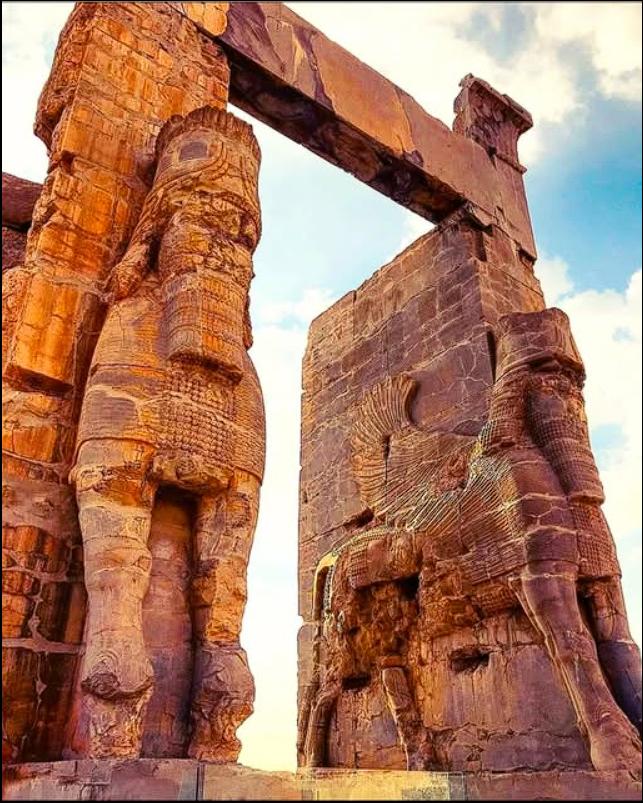Erected in the flourishing 5th century BC, the Gate of All Nations once stood as the magnificent and awe-inspiring principal entrance to Persepolis, the palatial and ceremonial heart of the vast and influential Achaemenid Empire. Commissioned by the ambitious Xerxes I, successor to Darius the Great, this monumental gateway was meticulously designed not merely as a functional portal but as a powerful architectural statement, intended to visually embody the sheer scale, unparalleled majesty, and sophisticated cultural vision of an empire that stretched across continents.
Colossal Guardians and Imperial Authority: The Symbolism of the Lamassu
Flanking the imposing entrance of the Gate of All Nations stood colossal and awe-inspiring statues of lamassu—mythical guardian figures seamlessly blending the formidable strength of bulls with the soaring freedom of eagles and the intelligent countenance of human heads. These majestic hybrid creatures served as potent symbols of both divine protection over the sacred city and the immense power and far-reaching authority wielded by the Persian king over his diverse and sprawling realm. Their imposing presence reinforced the notion of the Achaemenid ruler’s divinely sanctioned mandate to govern a multitude of peoples and lands.
Xerxes’ Vision: A Gateway to Imperial Majesty
Xerxes I, the visionary behind the Gate of All Nations, understood the power of monumental architecture to convey imperial might. By commissioning this grand entrance, he aimed to create an indelible first impression on all who approached Persepolis, immediately establishing the empire’s grandeur and sophistication.
The Mythical Lamassu: Protectors of the Realm
The choice of lamassu as guardians was steeped in ancient Mesopotamian tradition, adopted and adapted by the Achaemenids to symbolize royal protection and power. The bull’s body represented strength and virility, the eagle’s wings signified dominion over the skies and swiftness, and the human head embodied wisdom and intelligence—a potent combination reflecting the ideal attributes of a just and powerful ruler.
Divine Authority: Sanctioning Imperial Rule
By placing these mythical guardians at the empire’s ceremonial entrance, Xerxes subtly reinforced the divine authority underpinning his rule. The lamassu, often associated with celestial beings, suggested a cosmic endorsement of the Achaemenid dynasty’s right to govern their vast territories.
A Threshold of Diplomacy and Unity: Embracing Multiculturalism
However, the Gate of All Nations was far more than just an imposing and symbolic architectural marvel. Carved into its very fabric were inscriptions in the three primary languages of the Achaemenid Empire—Old Persian, Elamite, and Babylonian—serving as a multilingual greeting to the numerous foreign dignitaries, emissaries, and travelers who passed through its monumental portals. This deliberate linguistic inclusivity served as a tangible reflection of the empire’s progressive and remarkably tolerant multicultural identity, a hallmark of Achaemenid rule. The gate functioned as both a literal physical threshold, marking the entry into the heart of Persepolis, and a profound symbolic threshold, signifying entry into a world meticulously shaped by diplomacy, mutual tolerance, and the overarching ideal of imperial unity among a diverse array of cultures and peoples.
Multilingual Inscriptions: A Testament to Tolerance
The presence of inscriptions in Old Persian, Elamite, and Babylonian highlights the Achaemenid Empire’s commitment to acknowledging and integrating the diverse linguistic groups within its borders. This act of linguistic inclusion facilitated communication and fostered a sense of belonging among the empire’s various subjects.
Welcoming Foreign Dignitaries: A Hub of Diplomacy
The Gate of All Nations served as a crucial point of reception for foreign delegations arriving at Persepolis to pay homage to the Persian king, negotiate treaties, or offer tribute. Its grandeur was intended to impress upon these visitors the power and sophistication of the Achaemenid court, setting the stage for diplomatic interactions.
Symbolic Unity: Bridging Diverse Cultures
By creating a grand entrance that acknowledged the empire’s multiculturalism, Xerxes symbolically emphasized the Achaemenid ideal of unity in diversity. The gate represented the empire’s ability to bring together disparate cultures under a single, benevolent rule, fostering a sense of shared identity and purpose.
Enduring Legacy: A Glimpse into a Lost Empire’s Vision
Though now weathered and scarred by the relentless passage of millennia, the majestic remains of the Gate of All Nations continue to stir a profound sense of awe and wonder in those who stand before them. These ancient stones offer a vivid and tangible glimpse into the ambitious vision and remarkable achievements of an empire that once stretched from the fertile plains of the Indus Valley in the east to the vibrant shores of the Aegean Sea in the west—a lasting and enduring monument to Persia’s unparalleled architectural brilliance, its progressive cultural vision, and its enduring impact on the course of ancient history. The Gate of All Nations stands as a silent yet powerful testament to a civilization that understood the power of both imposing grandeur and inclusive governance.

CÁC TIN KHÁC
Mary Walton: The Forgotten Inventor Who Helped Clean Up America’s Cities
Tomb of Queen Nefertari in the Valley of the Queens, Egypt
Discover the Hypostyle Hall of the Temple of Hathor at Dendera
Venus de Losange: Unveiling the Mystery of a 20,000-Year-Old Paleolithic Icon